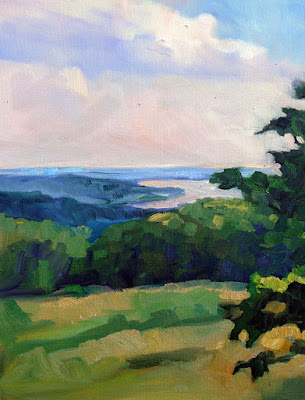Is there anyone in America who doesn’t understand that white colonists were bad? How does pissing on Frederic Church’s front lawn help?
 |
| Photo courtesy of Jamie Williams Grossman. |
OVERLOOK: Teresita Fernández confronts Frederic Church at Olana opened on May 17. I like the management of Olana, which is very welcoming to landscape artists, so I feel badly writing this. But Jesús Rafael Soto’s installation on the lawn violates the work of art closest to Frederic Edwin Church’s heart—Olana itself.
By 1876, Church—the most successful artist of his day—was crippled by rheumatoid arthritis. Compensating, he poured his heart into the design of the house and grounds at Olana, shaping the landscape as a frame for magnificent views of the Hudson and far Catskills. Obliterating the views with a cascade of urine-colored plastic defaces his vision.
 |
| Photo courtesy of Jamie Williams Grossman. |
Olana’s grounds are a mecca for landscape painters. New York Plein Air Painters holds its annual retreat there. The historic site holds an annual plein air painting event. Many artists, including my friend Jamie Williams Grossman, who took these photos, visit there regularly to paint.
“Fernández seeks to respond to their interpretations and biases through a conversation about a deeper sense of these varied American cultures, contesting the iconic view of the ‘American Landscape’ painting tradition constructed by Church and his peers that often omitted or erased other narratives and figures,” read Olana’s press release.
Yawn. The problem with much conceptual art is that its ideas are so often stale. Is there anyone in America who doesn’t understand that white colonists ignored native cultures? How does pissing on Church’s front lawn help?
Of course, the overwriting of culture in South America wasn’t done by Church and his painterly peers. It was done by the rapacious, vicious Spanish, who were the worst of colonists. If the artists in this show want a serious talk about cultural appropriation, they could start by examining their own Hispanic surnames.
Church didn’t paint the people and cultures of South America for the same reason he didn’t paint the Inuit above the Arctic Circle or the settlers at Niagara: he was a landscape painter, interested in natural science. What human habitation exists in his structures is incidental, there to create visual interest.
 |
| Because of Church’s clever site design, Soto’s sculpture mucks up almost every great view from the lawn. Photo courtesy of Jamie Williams Grossman. |
He was painting for an audience which had little opportunity to understand the New World. Science was beginning to be popularized in the nineteenth century, but it was still very much a gentleman’s pursuit. Mass media was in its infancy.
“The vastness of this continent were yet unrevealed to us,” wrote S. G. W. Benjamin in 1879. “With the enthusiasm of a Raleigh or a Balboa he [Church] has explored land and sea, combining the elements of explorer and artist… Our civilization needed exactly this form of art expression at this period, and the artist appeared who taught the people to love beauty and to find it.”
|
Olana overlook, approaching sunset, 12X16 oil, by little ol’ me. I’ve painted this scene many times, and it never grows old.
|
“This marks the first time Soto’s immensely popular interactive sculpture will be experienced by the public in a naturalistic setting, and it’s the first time it will be seen on the East Coast.”
It may have been immensely popular in Los Angeles, but it’s obscuring the view in Hudson. I won’t be painting there this season.











